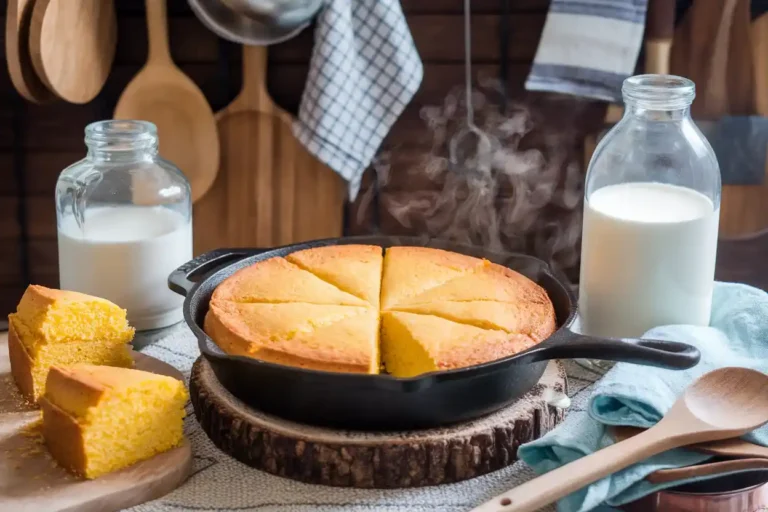Cornbread, a staple in many households, is a dish that stirs debate among home cooks and culinary enthusiasts. One of the most discussed topics is whether buttermilk or milk creates the best cornbread. These two ingredients may seem interchangeable, but they bring unique qualities to the table, from flavor to texture. This article dives deep into the buttermilk vs. milk debate, breaking down their differences, benefits, and best uses. Whether you’re chasing that perfect tangy crumb or aiming for a lighter loaf, we’ve got you covered. Let’s start by exploring why this question matters in cornbread recipes.
Table of Contents
Introduction to the Buttermilk vs. Milk Debate
The Role of Liquid in Cornbread Recipes
The liquid in cornbread recipes isn’t just about binding ingredients; it plays a crucial role in the bread’s texture, flavor, and rise. Liquids like buttermilk or milk activate the leavening agents such as baking powder or baking soda and help distribute moisture evenly. This ensures the cornbread doesn’t turn out dry or dense.
Both buttermilk and milk are commonly used, but their impact varies significantly. Buttermilk, with its tangy profile, offers a distinctive richness, while milk provides a subtler flavor and a softer texture. Each liquid brings its own twist, making the choice more than just a matter of convenience.
Why This Question Matters in Cornbread Preparation
So, is it better to use buttermilk or milk in cornbread? The answer depends on what you’re after. Buttermilk lovers swear by its ability to create moist, flavorful cornbread with a slightly dense crumb. On the other hand, milk is often favored for its accessibility and the light, fluffy texture it provides.
Understanding the differences between these two ingredients can help you tailor your cornbread to suit your taste and occasion. Whether you’re aiming for traditional Southern cornbread or a sweeter Northern variation, your choice of liquid sets the tone.
Overview of the Main Differences
In a nutshell, buttermilk adds tanginess and richness, while milk lends mildness and lightness. But it doesn’t stop there. Factors like how these liquids interact with leavening agents and their effect on texture make them distinct. As we delve deeper into their individual roles, you’ll see how each can shine in its own way.
What Buttermilk Brings to Cornbread
How Buttermilk Enhances Flavor
Buttermilk is a game-changer when it comes to flavor in cornbread. Its tangy, slightly acidic taste adds depth, balancing the natural sweetness of the cornmeal. This tanginess not only enhances the overall flavor profile but also complements savory dishes like chili or greens. If you’ve ever wondered, “Is it better to use buttermilk or milk in cornbread?” the unique taste of buttermilk is a strong argument in its favor.
Additionally, the buttery undertones of buttermilk create a rich, savory cornbread experience that feels indulgent yet comforting. This makes buttermilk a popular choice in traditional Southern-style recipes, where bold flavors are a hallmark.
Impact on Texture
The texture of cornbread made with buttermilk is noticeably moist and tender. This is due to the higher fat content in buttermilk, which enriches the batter. The result is a crumbly yet soft bread that’s perfect for soaking up sauces or stews.
Buttermilk also contributes to a denser consistency compared to milk. While some prefer a lighter texture, others enjoy the substantial, hearty quality that buttermilk-based cornbread provides. It’s a texture that pairs well with robust, flavorful meals.
The Chemical Advantage of Buttermilk
Buttermilk offers a unique advantage in recipes that call for baking soda. Its acidity reacts with the baking soda to create carbon dioxide, which helps the batter rise evenly. This interaction results in a fluffy yet structured bread that doesn’t collapse after baking.
In contrast, milk lacks the acidity needed for this reaction, which can impact the rise and texture of the bread. For bakers looking for consistent results, buttermilk is often the more reliable option.
Using Regular Milk in Cornbread
How Milk Affects Flavor
Milk, while less tangy than buttermilk, brings a subtle sweetness and neutrality to cornbread. This makes it an excellent choice for those who prefer a milder flavor or are serving cornbread alongside spicy dishes. Milk-based cornbread doesn’t overshadow other flavors, making it versatile for various meals.
Though it lacks the complexity of buttermilk, milk allows the natural taste of the cornmeal to shine through. It’s a great choice for Northern-style cornbread, which often incorporates a bit of sugar for a sweeter profile.
Texture with Milk-Based Cornbread
Cornbread made with milk tends to be lighter and fluffier than its buttermilk counterpart. This is because milk has a lower fat content, which creates a more airy consistency. If you enjoy cornbread with a cake-like texture, milk is a fantastic option.
However, the lighter texture may not hold up as well with heavy or saucy dishes, as it’s more prone to crumbling. For everyday use or as a standalone snack, though, milk-based cornbread is an easy and satisfying choice.
Adjustments Needed When Using Milk
When substituting milk for buttermilk, a small adjustment can make all the difference. Adding a teaspoon of lemon juice or vinegar to a cup of milk creates a buttermilk-like acidity. This simple trick allows milk to mimic the tangy properties of buttermilk, ensuring your cornbread rises properly.
If you’re in a pinch, this substitute works well and maintains the integrity of the recipe. It’s a handy solution for those who don’t have buttermilk on hand but still want to achieve a similar outcome.
Comparing Taste and Texture

The Tangy vs. Sweet Profile
When it comes to flavor, the question “Is it better to use buttermilk or milk in cornbread?” often boils down to personal preference. Buttermilk imparts a tangy, savory taste that complements hearty meals like chili, beans, or stews. Its acidity adds a subtle complexity that enhances the bread’s overall flavor.
Milk, on the other hand, provides a more neutral base. This allows other ingredients, such as sugar or honey, to stand out. Milk-based cornbread tends to be slightly sweeter, making it an excellent choice for breakfast or as a side for spicy dishes.
Moistness and Density Differences
The choice between buttermilk and milk also affects the texture of cornbread. Buttermilk creates a denser, moist loaf that holds together well, even when paired with saucy or wet dishes. This texture makes it ideal for Southern-style recipes where the bread is often used to soak up rich gravies or juices.
Milk, in contrast, yields a lighter, fluffier bread with a crumbly texture. This type of cornbread is less heavy and works well as a standalone snack or dessert when paired with a touch of butter and jam.
What Works Best for Different Pairings
If you’re serving cornbread alongside robust dishes like barbecue or gumbo, buttermilk-based recipes offer the perfect savory complement. The tanginess balances out the richness of these meals, creating a harmonious plate.
For sweeter pairings, such as honey-glazed chicken or a breakfast spread, milk-based cornbread is a winner. Its mild flavor and airy texture make it versatile and appealing to a wider audience.
Nutritional and Practical Considerations
Buttermilk’s Nutritional Profile
Buttermilk isn’t just flavorful it’s also packed with nutrients. Rich in calcium, potassium, and probiotics, it promotes gut health and supports strong bones. Additionally, its lower fat content compared to regular milk makes it a lighter option for those watching their calorie intake.
The probiotics in buttermilk also aid digestion, making it a popular choice among health-conscious cooks. For individuals with lactose intolerance, cultured buttermilk can be easier to digest, offering a win-win solution for flavor and nutrition.
Milk as an Accessible Option
Milk, however, shines in terms of convenience. Most households have milk readily available, making it the go-to choice for last-minute baking. Its neutral flavor profile also allows for greater versatility in recipes, from cornbread to pancakes and beyond.
For those who prefer plant-based options, milk substitutes like almond or oat milk can be used with minor adjustments. These options make milk-based cornbread recipes more inclusive for dietary preferences or restrictions.
Substitutes for Buttermilk and Milk
If you find yourself without buttermilk, don’t fret! A simple mix of milk and lemon juice or vinegar creates a quick substitute. Similarly, unsweetened plant-based milks can be soured with the same method to mimic buttermilk’s tanginess.
For those who want to explore more cornbread alternatives or variations, try incorporating different liquids or add-ins to experiment with flavor and texture.
Popular Opinions and Regional Preferences
Southern Preferences for Buttermilk
In the South, buttermilk has a longstanding history in cornbread recipes. It’s not just a choice it’s a tradition. The tangy, rich flavor of buttermilk perfectly complements Southern staples like fried chicken, collard greens, and gumbo. Many cooks swear that buttermilk makes the best cornbread, creating a savory bread with the ideal density and moisture.
Buttermilk also aligns with the no-sugar rule many Southerners follow. Sweetness is reserved for desserts, while savory cornbread, enhanced with buttermilk’s slight acidity, remains a true Southern classic. The use of buttermilk often reflects the region’s culinary values: bold flavors, rustic methods, and simple ingredients done well.
Northern Variations with Milk
Meanwhile, in the North, milk often takes center stage in cornbread recipes. Northern-style cornbread leans toward the sweeter side, often including sugar or honey for a cake-like quality. Milk’s neutral flavor allows these sweet elements to shine, creating a bread that pairs beautifully with hearty chili or as a comforting breakfast treat.
While some Northern cooks might prefer buttermilk for added richness, milk’s accessibility and versatility make it the more common choice. The lighter texture of milk-based cornbread is also better suited for those who enjoy a fluffier bread.

FAQs About Buttermilk and Milk in Cornbread
What is the difference between cornbread and southern cornbread?
The primary difference lies in flavor and ingredients. Southern cornbread is typically savory and made with buttermilk, while traditional cornbread recipes, especially in the North, are sweeter and use milk. Southern cornbread often omits sugar, highlighting buttermilk’s tangy taste, whereas Northern recipes embrace a softer, cake-like texture.
Why do Southerners not put sugar in cornbread?
The omission of sugar in Southern cornbread ties back to tradition and practicality. Early Southern cooks relied on coarsely ground cornmeal and buttermilk, which naturally enhanced the flavor without needing additional sweetness. Savory cornbread pairs better with rich, flavorful dishes like greens or barbecue, making sugar unnecessary.
Can you substitute milk for buttermilk in cornbread?
Absolutely! If you’re in a pinch, milk works as a substitute for buttermilk. However, to replicate buttermilk’s acidity, add a teaspoon of lemon juice or vinegar to one cup of milk and let it sit for a few minutes. This DIY solution ensures the cornbread rises properly and has a balanced flavor.
What are the best dairy-free substitutes for cornbread?
For those avoiding dairy, unsweetened almond milk, soy milk, or oat milk can replace milk. To mimic buttermilk’s tanginess, mix these plant-based milks with a bit of lemon juice or vinegar. Coconut milk is another option but may slightly alter the flavor profile, adding a touch of sweetness.
Conclusion: Choosing Between Buttermilk and Milk
When to Choose Buttermilk
If you’re after cornbread with a tangy flavor, moist texture, and a dense crumb, buttermilk is the clear winner. Its slight acidity not only elevates the taste but also interacts with leavening agents to ensure a consistent rise. Buttermilk is perfect for savory dishes like collard greens, chili, or fried chicken, making it a staple in Southern kitchens. Additionally, its nutritional benefits, including probiotics and vitamins, make it a wholesome option for many.
Choosing buttermilk also aligns with traditional Southern recipes, where its rich and tangy flavor is a signature feature. If the thought, “Is it better to use buttermilk or milk in cornbread?” leaves you leaning toward bold, savory dishes, then buttermilk is your best bet.
When Milk Is a Better Fit
Milk is ideal for those who prefer a lighter, sweeter cornbread. Its neutral flavor allows other ingredients, like sugar or honey, to shine, making it perfect for Northern-style recipes. Milk-based cornbread is versatile, pairing well with spicy dishes or as a sweet treat with butter and jam.
For convenience, milk wins hands down. Most kitchens have milk readily available, and it works beautifully when you’re short on buttermilk but still want a satisfying result.

